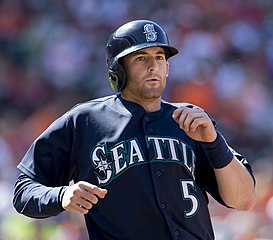DEPARTURES
- 1B/"OF" Mark Trumbo and LHP C.J. Riefenhauser traded to the Orioles for C/1B/3B Steve Clevenger - Trumbo was likely to earn around $9 million with a skillset that is essentially the antithesis of what we've come to expect from Dipoto. Trumbo is a very limited defender with minimal on-base skills. Riefenhauser was acquired earlier this offseason from the Rays, which means Dipoto has now traded someone he traded for! That seemed inevitable with his wheeling and dealing. In return, the Mariners got a replacement-level catcher who may or may not allow the M's to give Mike Zunino some development time in AAA. I suppose he adds some defensive versatility too. The Mariners gave up more talent than the Orioles in this trade, but also shed Trumbo's salary and opened up a roster spot to sign someone more in Dipoto's mold.
- OF/3B Patrick Kivlehan traded to the Rangers as the player to be named later in the Leonys Martin deal - Kivlehan is significant by player-to-be-named-later standards, and he has a chance to carve out an MLB career. It stings a bit to see him leave. However, he helped the Mariners get the center fielder they needed, and his loss opens up another 40-man roster spot.
- RHP Jose Ramirez traded to the Braves for a player to be named later or cash considerations - Ramirez has control problems but a big arm with some home run troubles. He is not all that far off from the Dipoto mold for pitchers, and Dipoto wants to build up pitching depth. However, he decided that whatever talent Ramirez possesses on the mound did not outweigh the added roster opening at this stage in the offseason. The move reduced the M's from a full 40-man roster to 39. I think it is safe to assume that Ramirez was going to get cut loose at some point in the near future when the Mariners acquire yet another player, and Dipoto found a team who wanted Ramirez bad enough to give the Mariners something.
ARRIVALS
- 1B Andy Wilkins, via waiver claim - I don't have much to say about this one. He looks like AAA depth, though Dipoto took the time to claim him on waivers and use a 40-man roster spot on him. This probably says more about his (lack of) faith in Jesus Montero than anything else.
- OF Nori Aoki, via free agency - I wrote about this move yesterday.
- RHP Justin De Fratus, via free agency - De Fratus fits the mold for Dipoto bullpen arms. Some success in the past, but not last year, despite underlying peripheral stats that suggest no real change in overall skill.
- Steve Clevenger, as already mentioned above in the Trumbo trade.
I think it is easier to think of all these separate deals as one big deal because then some clearer trade-offs emerge.
Mark Trumbo was probably a first baseman with the re-worked Mariners roster. He is gone and Wilkins takes his place on the depth chart. Wilkins is not as good as Trumbo, but he also costs $8+ million less. Trumbo was about to become an overpriced starter that produced some value, but not an incredible amount.
Nori Aoki takes Patrick Kivlehan's spot on the roster. This is a clear upgrade for 2016. His salary is also negligible because he costs about as much as Trumbo did in 2015. A trade of Trumbo and Kivlehan for Aoki and Wilkins makes quite a bit of sense for the Mariners. It makes them a better team in 2016 and could only look bad in the years to come if Kivlehan develops into an everyday player in Texas.
Jose Ramirez and Justin De Fratus essentially trade places too. This is another upgrade for the Mariners. De Fratus struggled last year, but he was still better than Ramirez and also comes with a track record of modest success in the majors.
That leaves C.J. Riefenhauser and Steve Clevenger as the final pair in this overall deal. This one is more abstract to figure out since they do not play the same positions. The overall value might be equal here. Clevenger plays the more demanding position (catcher) and has a little more success in the majors to his name, but he is also out of minor league options. Additionally, Riefenhauser is left-handed, which should account for something. However, Clevenger's presence allows the Mariners to much more comfortably make the right decision with Mike Zunino's development. If Zunino can develop into the star that many think he can be as a result of this little depth-bolstering move, then this is a huge gain for the Mariners.
So, overall, the only downgrade the Mariners made this week was at first base, but in the process they got better in several other areas. Moreover, the value they lost at first base should be relatively easy to replace at some point in the offseason. Dipoto might solve first base tomorrow at the rate he is going. The M's 40-man roster stands at 39 players so he might already have someone lined up for all we know.
Still, even before Jerry Dipoto find the M's starting first basement for 2016, the moves this week make sense when considered together. He is doing the equivalent of roster gerrymandering - trying to reallocate skill levels in different levels and different places which will make wins pile up better.
